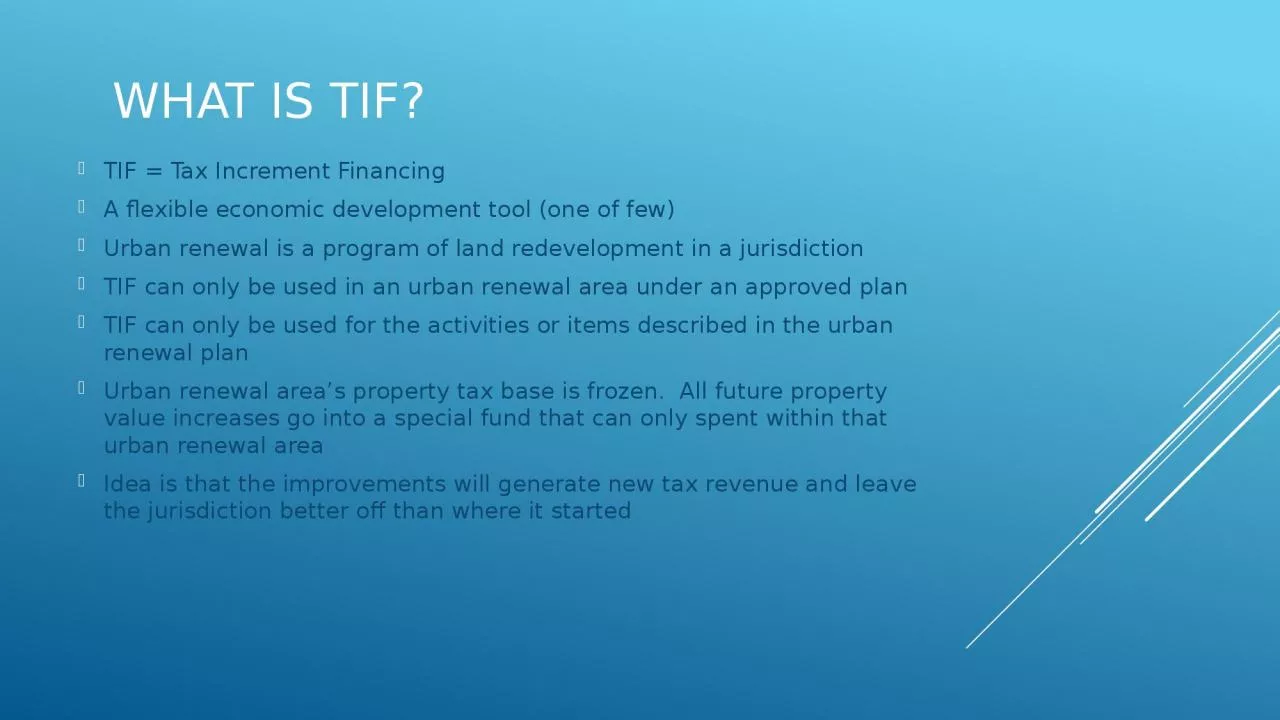

A flexible economic development tool one of few Urban renewal is a program of land redevelopment in a jurisdiction TIF can only be used in an urban renewal area under an approved plan TIF can only be used for the activities or items described in the urban renewal plan ID: 1017699
Download Presentation The PPT/PDF document "What is TIF? TIF = Tax Increment Financi..." is the property of its rightful owner. Permission is granted to download and print the materials on this web site for personal, non-commercial use only, and to display it on your personal computer provided you do not modify the materials and that you retain all copyright notices contained in the materials. By downloading content from our website, you accept the terms of this agreement.
1. What is TIF?TIF = Tax Increment FinancingA flexible economic development tool (one of few)Urban renewal is a program of land redevelopment in a jurisdictionTIF can only be used in an urban renewal area under an approved planTIF can only be used for the activities or items described in the urban renewal planUrban renewal area’s property tax base is frozen. All future property value increases go into a special fund that can only spent within that urban renewal areaIdea is that the improvements will generate new tax revenue and leave the jurisdiction better off than where it started
2. Process to adopt UR plan/TIFDetermination of purpose by jurisdictionDraft plan, maps, legal description, and financial projectionsBoard/Council Meeting – Set Public HearingMeeting of taxing entities (school district, county, city, community colleges, etc.)Board/Council Meeting – Hold Public Hearing/Approve PlanImplement Plan over duration of timing of project(s)
3. When does a Tif district end?If the TIF district is:Slum/blight: UnlimitedEconomic Development for Housing: 10 YearsEconomic Development for Non-Housing: Up to 20 yearsWhen a TIF district ends, the full tax base including the increment, becomes available to all taxing bodies for their use
4. Access TIF for a project?Project has to be located within an urban renewal area.Project is real estate-based with an increase in taxable valuation. In addition, jurisdiction may determine other policy reasoning like job creation and/or extraordinary development costs.Best practice is that the project would show why TIF is needed; what is the financial “gap”?Also, best practices would propose to have bank/financing/investors on board and completed pro-forma before coming to jurisdiction with a request.
5. TIF ExampleThe “frozen” base assessment of a property is $100,000After project is developed, the taxable value is $150,000 Yr. Taxable Value Prop. Tax Revenue 1 $100,000 $4,000 2 $150,000 $6,000The tax increment valuation is $50,000 (new assessment minus the frozen assessment or $150k-$100k). The new tax increment revenue of $1,800 is available for use within the designated urban renewal area ($200 is additional revenue for protected levies – see next slide for more detail)
6. Who Gets the Money?Frozen Valuation of $100,000:The $4,000 property tax revenues from the “frozen” valuations continues to go to:School District - $2,120 (53% of tax levy)County - $1,320 (33% of tax levy)Hospital - $280 (7% of tax levy)Other (community college, township, etc.)- $280 (7% of tax levy)The $200 of new revenue go for the protected levies (school PPEL, county debt service, city debt service, etc.)By state law, the jurisdiction can use all of the new revenue - $1,800 - on projects in the specific urban renewal area
7.
8. When does tif not work?TIF can go “upside-down” if the tax base goes below the frozen levelThis can happen if buildings are demolished, properties receive tax exemptions, or property tax assessments are successfully challenged, which then reduces the property tax assessment
9. Exercise
10. Questions ?